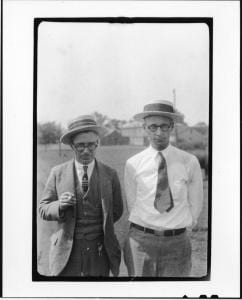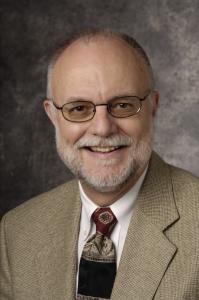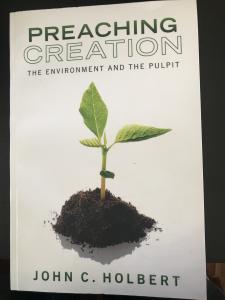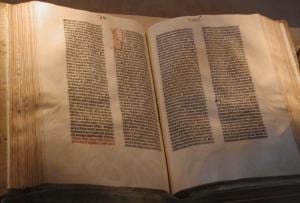
In my last essay I made an imaginative attempt to reconstruct possible ways that the Bible we now easily hold in our hands grew from tales around campfires in the ancient near east to a canonical book that served the Christian church, as well as the lives of Jews in their diaspora, without the books of the New Testament, of course, as the norm for faith and life. In today’s article, I propose to look at the myriad ways that the church and synagogue read the biblical text in order to employ its precepts and commands in ever new social circumstances. As in my first treatise, I can only offer the barest of summaries of the issues surrounding the question, but I think it is valuable still to get a sense of the ways in which the Bible has been read through the centuries to offer insights into the ways it is being read now in 2020, the subject of my final essay on the Bible.
It is fair to say that for perhaps 1500 years of Bible reading, confined as it was primarily to the learned rabbis and priests, prior to the invention of the printing press, the Bible was read in immensely complex ways. The so-called surface reading, that is listening to the words themselves in their own literary contexts, was viewed as the least significant approach to understanding. For centuries of readers it was the spiritual meaning hidden beneath the actual words that was most significant. This method led, obviously, to wildly imaginative reflections on biblical meaning. Allegory ran rampant, as words were made to mean nearly whatever any given reader claimed them to mean. This may have been less true among the rabbis, who generally took the actual words of the text and their meaning more seriously than their Christian counterparts, but allegory was by no means absent from rabbinic readings either. For example, interpretations of books like the Song of Songs, clearly quite earthy love poetry, were read so as to expunge the surface meanings by finding a hidden spiritual intent in the words. The relationship between the man and the woman in the Song was said to imply the relationship between YHWH and Israel (Jewish) or Christ and the church (Christian). One Christian reader, when confronted with a statement about the beauty of the woman’s navel claimed that the intent of the image was to depict the baptismal bowl! Some of these interpretations make for hilarious modern reading, but when a reader is freed from taking what the words actually say seriously, all manner of creative and ludicrous conclusions can be reached, and they regularly were.
However, underlying these official readings could be found in nearly every century those who looked at the text quite differently. Rabbis very early in the 2nd or 3rdcenturies CE recognized and commented that Gen.1 and 2 employed two different names for God, suggesting that perhaps two different writers were at work; maybe Moses did not write the Pentateuch as the official belief ran. A French physician, Richard Simon, made the same discovery much later in the 16th century, when he read the Hebrew text. Though some would have judged these observations little less than blasphemy, reactions that led to horrific deaths for some, the notions that the Bible was not exempt from critical evaluation became crucial as the European Enlightenment took hold. The emerging movement of humanism in the 15th and 16th centuries, represented best by Lorenzo Valla, who critically demonstrated that the so-called “Donation of Constantine,” wherein Constantine the Great supposedly gave the land of the Vatican state to the church in the 4th century, was in fact a forgery, and Desiderio Erasmus, who wrote the first critical edition of the Greek New Testament, thus opening up the vast critical apparatus of serious textual study, laid the foundation of Biblical criticism that continues today. Then, with the rise of secular historiography, biblical critical reading began in earnest, and there was no turning back to those simpler days of “official” readings.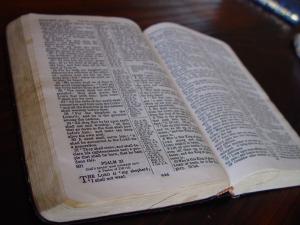
In the 17th and 18th centuries, especially in Germany, biblical criticism began in earnest. This criticism was based squarely on the notion that if the Bible was in reality written by human beings, who purported in the texts to report actual events, then it was right and necessary to ask those texts the question of truth, a question that must be asked of all humanly produced writing. And once the truth question is asked, then it follows that some standard of judgment must be realized to evaluate the truth or falsity of historical claims, a standard that is necessarily influenced by present knowledge and the various sciences. Only then, it was said, that contemporary historians were enabled to sort out the fantastic, legendary, and mythological elements from the potentially historically true ones. For an early example, the report that the walls of Jericho fell down at the blast of trumpets from Joshua’s ragtag army ran up against the fact, determined by archaeological examination of the ancient city, that no one may have been living there when Joshua and the people of Israel entered into the Promised Land. Hence, that report may be classed as legend, not history. The immediate theological result of studies like that one was to challenge the long-held belief in the verbal inspiration and inerrancy of the Scriptures. That led, particularly in the late 19th century to the rejection by biblical critics of many judgments of traditional beliefs.
(1)The first five books of the Bible were not written by Moses, but were instead the product of multiple hands; (2) the book of Isaiah was not one book but actually at least three different prophets, and probably more; (3) the book of Daniel was not written in the time in which the tale is set, but several centuries later; (4) the Gospel of John is radically different from the other three gospels and thus can provide no dependable framework for the life and teaching of Jesus; (5) the authors of Matthew and Luke probably copied the work of Mark (the Synoptic Problem); (6) it is finally impossible to reconstruct any real history of Jesus’s ministry; (7) Paul did not write several of the letters attributed to him. These are only a handful of the many traditions long espoused by Bible readers that under the glare of the work of biblical critics needed serious revision.
There was an immediate and full-throated backlash against these views, both from fundamentalists, who rejected “higher criticism” as inimical to the faith of the ages, and from Roman Catholics who saw this critical stance toward the Bible as dangerous for church dogma. Orthodox Judaism also rejected the findings of the higher critics. The Catholics established in 1902 a Biblical Commission to ensure that no Roman Catholic scholar advocated historical views that were judged alien to traditional church teachings. It was not until the late 1940’s that Roman Catholic scholars were fully freed to pursue their research into the Bible, though the Vatican Index still operates at times to reject biblical research that runs afoul of one idea or another.
The struggle between unfettered biblical research and the fundamentalist forces of the church that oppose any such treatment of the Bible is still active. When in 1927 John Thomas Scopes was found guilty in a Tennessee courtroom of teaching Darwin’s evolution, having been defended by William Jennings Bryant and opposed by Clarence Darrow, some progressive Christians imagined that any fundamentalist belief system had been quashed forever by the withering and unyielding assaults by Darrow on the Bible and the unfortunate foolishness of one of America’s great politicians, Bryan; they were sadly mistaken. Fundamentalism, and its many adherents, merely went underground for a time, later to arise publically in the 1970’s and 1980’s under the leadership of minister politicians like Jerry Falwell, Pat Robertson, Robert Jeffress and a host of others who carry on the same fight, with several modern nuances, that Darrow and Bryan engaged in nearly 100 years ago.
Thus, in 2020 we can still witness progressive biblical scholarship, represented by nearly all scholars in mainline colleges and seminaries in the US, and even in some traditionally conservative ones, and around the world, confronted by very conservative, neo-fundamentalist scholars in independent colleges, universities, and seminaries. This struggle now goes on against the backdrop of a decidedly less interested populace, whose devotion to all things religious is on the wane. We might ask today: is this fight for the Bible of any real value now, as the church struggles to survive in an increasingly secular age? My next essay will try to reflect on that, among other issues, as I ask how the Bible is being read in 2020.
(Images from Wikimedia Commons)